Ayeres' grand loop
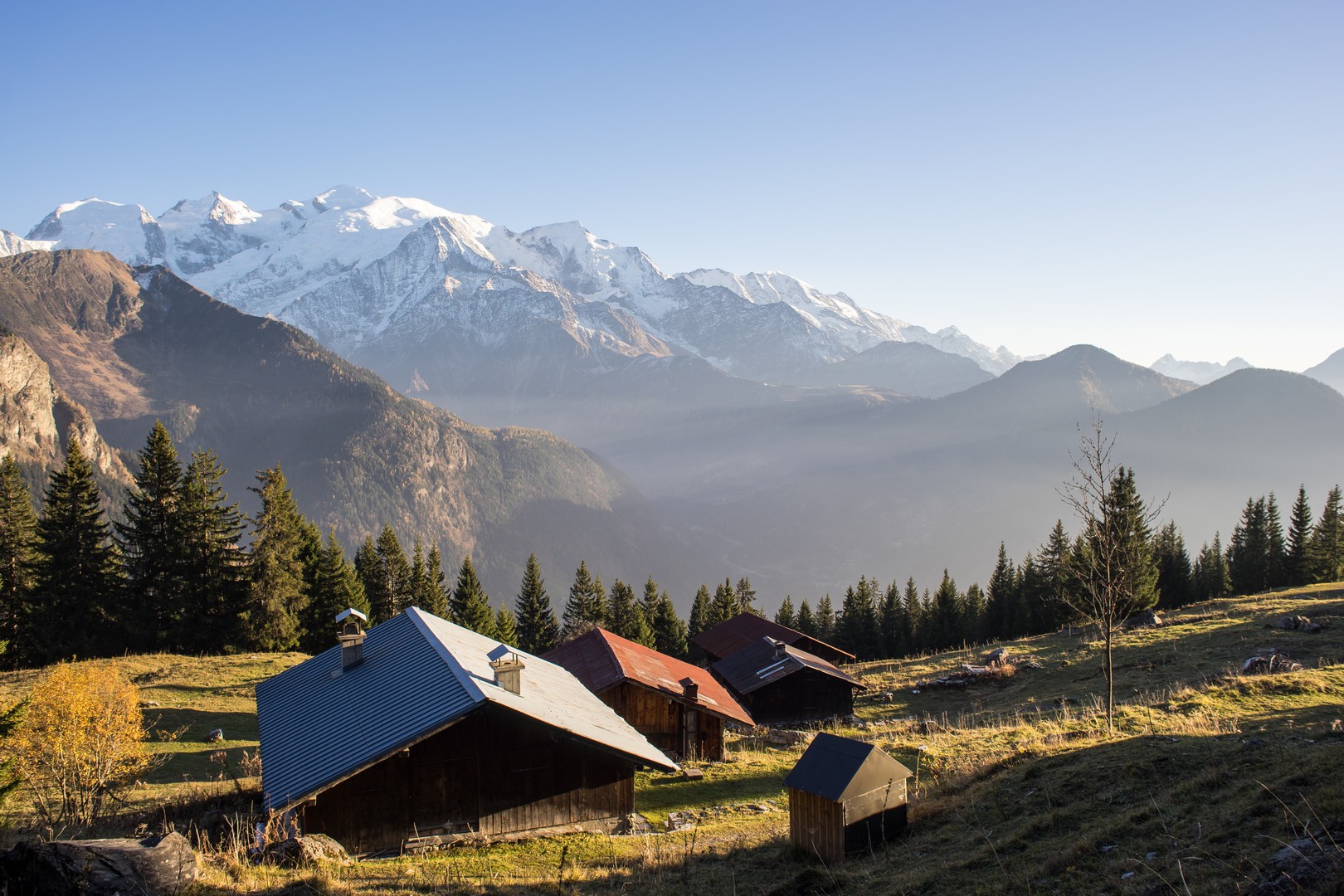
Passy
Ayeres' grand loop
Easy
3h
8,6km
+402m
-402m
Embed this item to access it offline
Initially, the trail immerses you in the forest, featuring the charming Lac Vert. Then the route climbs higher, revealing alpine hamlets that are a testament to the pastoral life of yesteryear. The route then takes you across a panoramic view of Mont-Blanc before plunging back into the forest on a wide track.
Attachment
- Downloadpdf
le-grand-tour-des-ayeres
Credit: Points d'intérêts du parcours - Asters-CEN74
23 points of interest

Muséographie Maison de la réserve - Julien Heuret - CEN 74 
La Maison de la Réserve
The exhibition an information office Maison de la Réserve naturelle de Passy is located in Plaine-Joux and welcomes you during the school holidays. The permanent exhibition about fauna, flora and landscapes will open the doors to the nature reserve. You may find answers to some of your questions here and can admire the wild species hidden in nature. If the Maison de la Réserve Naturelle is closed, don’t worry, go up to the passageway. There is permanent free access to information about former (geological times) and present landscapes, the wonders of biodiversity, and the great challenges of the mountains of the future (water, glaciers, global warming...).
Aigle royal en vol - Julien Heuret - CEN 74  Fauna
FaunaGolden Eagle cainism
Two chicks will hatch from their eggs just a few days apart in their rock wall nest. Only one will have a chance of surviving: the weaker one will be eliminated by the stronger one! In biology, this behaviour is called "cainism". It is a common phenomenon among daytime birds of prey, part of a species survival strategy that selects the strongest offspring from birth to increase their chances of reaching maturity. It's a huge undertaking for the parents to feed a ravenous hatchling, which can grow from 100g at birth to 5kg by the time it flies!
Bouquetins - Julien Heuret - CEN 74  Fauna
FaunaAlpine ibex
The Alpine ibex is not particularly shy, especially compared with the chamois, with which it often shares its territory. Unlike most other mountain species, it remains at high altitudes even when winter and snow are approaching. It then heads for the ridges and snow-free areas where it can more easily find the grasses on which it feeds. This search for food takes a lot of energy. So, if you come across one, don't approach it and let it move away at its own pace so that it doesn't expend its energy unnecessarily, especially in winter.
Panorama Mont Blanc - Julien Heuret - CEN 74  Geology
GeologyThe mont Blanc
Under the snow and glaciers, two major rocks form the Mont-Blanc Massif: the sharp edges and highest peaks are made of very hard granite (from left to right: Chamonix Needles, including the Aiguille du Midi, Mont Blanc du Tacul, Mont Maudit, Mont Blanc summit), while the rounder, softer parts are made of gneiss (from left to right: Dôme du Goûter, Aiguille du Goûter, Aiguille de Bionnassay....). These two so-called crystalline rocks come from the Earth's molten core.
Le Mont-Blanc depuis une prairie fleurie de Plaine-Joux - Lucie Rousselot - CEN 74 
History of Plaine-Joux
From woodland to mountain pasture, Plaine-Joux has not always been a ski resort. Its very name, which means "forest on a flat landscape", bears witness to this. As early as the 1930s, the residents of Passy were enjoying skiing on this site blessed with an exceptional panoramic view. It was around 1965 that it officially became a municipal ski resort. Today, Plaine-Joux remains a popular family resort for skiing, hiking, paragliding... or just admiring the scenery.
@JLFouquer  Fauna
FaunaThe Common Minnow and the Common Chub
The minnow is very common in highly oxygenated waters. The reason for its presence in high-altitude lakes is that trout fishing is common there. It is used as bait by anglers, which has enabled this species to spread to mountain lakes. The chub is a fairly large fish, widespread in France. It is an omnivore, meaning it eats everything. In many European countries, particularly in Eastern Europe, it is a major culinary delicacy.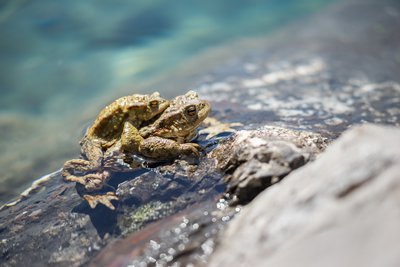
Amplexus crapaud - Julien Heuret - CEN 74  Fauna
FaunaThe common Toad
Kissing a toad and turning it into Prince Charming is a myth! You should never touch this protected species, which is vulnerable to the many diseases that humans can transmit to it. Instead, look into its eyes to see its horizontal pupil and orange iris. You can also see its parotoid glands at the back of its head. These are used to excrete a venom called "bufotoxin" to ward off any predators. The toad is a completely different species from the frog, living for the most part in the forest, out of the water, and only coming back to the water during the breeding season!
@NicolasPerrouchet  Fauna
FaunaThe Grass Snake
A semi-aquatic species, it is found mainly in wetlands, but also in drier areas where it is able to prey on amphibians (frogs, toads, salamanders and newts). Like all reptiles, it is a protected species! It can be recognised by its round pupils, its olive-grey skin and its double black and white or yellow neck. Its other distinctive feature: when it feels to be in danger, it spits out a foul-smelling liquid and then plays dead, revealing its two-coloured belly in the pattern of a piano keyboard!
Julien Heuret - CEN 74  Fauna
FaunaDragonflies
Odonates, more commonly known as dragonflies, belong to the insect family. They undergo two stages in their lives: a "larval" phase, which is aquatic, followed by a terrestrial phase, which marks adulthood. Dragonflies are predators: they are carnivores, feeding on different types of prey depending on their life stage. They also prey on other insects. Their habitat is strongly influenced by climatic conditions, and any change will have a major impact on their numbers. The destruction of their habitat, wetlands, is one of the main threats to dragonflies.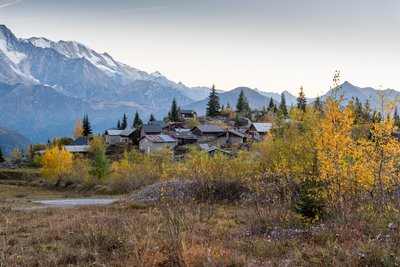
Chalets d'Ayères à l'automne - Julien Heuret - CEN 74 
The alpine cabin
The alpine cabine is a small building which, gattered with others, forms a small hamlet.
These constructions were originally intended for the organization of agricultural life in the mountains. These cabins were used in the summer to shelter the shepherds and their family. They were also used for milking and the production of cheese and other dairy products.
La porte d'entrée de la réserve - Julien Heuret - CEN 74 
The history of the Passy nature reserve
In the 1970s, the wealth of natural areas in Haute-Savoie was the subject of much interest. As developers grew increasingly ambitious and numerous tourist developments were planned, people began to raise concerns. The French government decided to create 9 national nature reserves. In 1974, the Aiguilles Rouges national nature reserve was created, followed by the Sixt-Fer à Cheval/Passy nature reserve in 1977. Between these two protected natural areas lay a small portion of land, which became the Passy nature reserve in 1980.
Chalets d'Ayères - Julien Heuret - CEN 74 
Architecture of alpine cabins
Some of the mountain shepherd cabins are over a century old.
The construction of sturdy high-altitude cabins is driven by its harsh immediate environment. Such cabins must feature stone walls and a spruce frame that can withstand deadly winter conditions!
Originally, the roof was covered with "tavaillons", a type of French traditional wooden tiles.
These buildings, used for farming in the summer months, were rudimentary and provided shelter for the shepherd and their family.
Les Fiz depuis les Ayères - Julien Heuret - CEN 74 
The 'Ayères'
The word "Ahier" originally comes from the Roman dialect for sycamore maple. The terms "pierrières" and "roc" come from the many boulders that formed during the rockslides at Dérochoir, including the one in 1751 that killed 6 people and a few domestic animals. All these cottages were mountain chalets used for farming. Now they are used as vacation homes.
Bouleaux en hiver - Julien Heuret - CEN 74  Flora
FloraThe Downy Birch (Betula pubescens)
There are four species of birch in Europe, and the one growing here is the downy birch. There are many proven medicinal properties of its sap and bark, such as natural detox properties and its ability to remedy rheumatism, fatigue and allergies! In the reserve, the birches are monitored as part of the "Phénoclim" programme set up by CREA to measure the impact of climate change on the life cycle of plants.
Sorbes - Julien Heuret - CEN 74  Flora
FloraThe Mountain Ash
It is a small tree that grows on the edge of forests. Its fruit, called "sorbs", are orangey red berries that are very popular with thrushes and blackbirds. They can be used to make brandy, jelly, or jam. Just make sure you pick them before they are ripe, otherwise, they may become toxic! In the reserve, the mountain ash is being studied as part of a collaborative science programme designed to measure the impact of climate change in the mountains.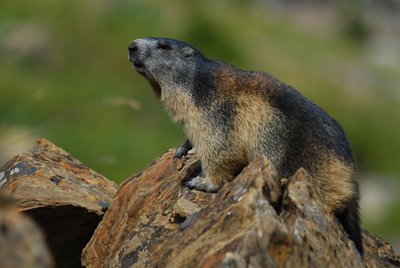
Marmotte - Frank Miramand - CEN 74  Fauna
FaunaWhistly song of a marmot
The Marmot is the favourite food of the Golden Eagle and, to a lesser extent, of the Fox. Always alert, the marmot surveys its surroundings to avoid being caught. Standing upright on its paws, its iconic stance reminds of a candle atop of a chandelier. Thanks to its very wide field of vision and its highly effective hearing and sense of smell, nothing escapes its notice. In the event of an emergency, it warns others with an audible cry: high-pitched and brief in the case of an airborne hazard, whistled and repeated in the case of a ground hazard. And that danger can be you!
Gélinotte des bois - Julien Heuret - CEN 74  Fauna
FaunaThe Hazel Grouse
This is the smallest and most elusive of the mountain Galliformes species. It is much less well known than the black grouse or the rock ptarmigan because it lives exclusively in the forest! But it is just as important from a biological and scientific point of view: this species is an excellent indicator of environmental change. Its specific requirements in terms of vegetation and variety of tree species put it at risk in the face of poor forest management. This is one of the main causes of the species' decline.
Pic noir  Fauna
FaunaThe Black Woodpecker
It is the largest of the 8 woodpecker species found in France. Originally an exclusively mountain-dwelling species, it now can also be found in the valleys! The Black Woodpecker adapts equally well to deciduous and coniferous forests, as long as they are large enough and have large-diameter old trees and some dead wood left. It is easily recognised by its entirely black plumage enlivened by a bright red spot, limited to the nape on the females and more extensive on the males.
Aigle royal en vol - Julien Heuret - CEN 74  Fauna
FaunaThe Golden Eagle
It's a predator, armed for the hunt! Thanks to its large, wide wings, it glides high into the sky in search of prey. Its exceptional eyesight spots marmots (its favourite meal), hares, foxes or ptarmigan, and sometimes even young chamois or ibex! Its prominent eyebrow arch acts as a sun shield when it swoops down to snatch its prey. It is equipped with talons for grabbing and a powerful, hooked sharp beak for tearing flesh.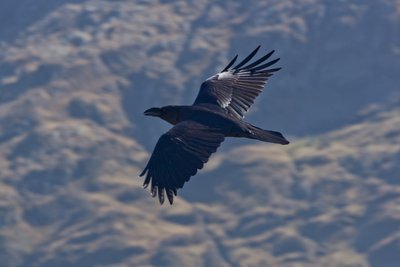
Grand corbeau en vol - Julien Heuret - CEN 74  Fauna
FaunaThe Common Raven
It is the largest of the passerines and corvids! Whether feared or revered, it is the subject of myths and legends in many cultures. Once hated and hunted, it is now protected. About the size of a buzzard, it can be recognised by its diamond-shaped tail and its throaty screech. It is an omnivore, which means it feeds on carcasses, eggs, chicks and berries! The couples, bound together for life, perform high-flying courtship displays! Apart from humans, its only predator is the golden eagle.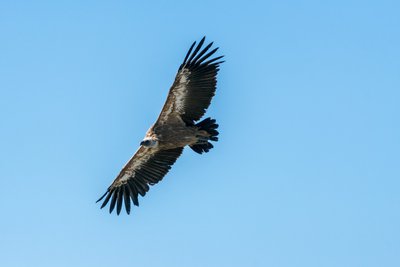
Vautour fauve en vol - Julien Heuret - CEN 74  Fauna
FaunaThe Griffon Vulture
It is a frequent summer visitor to Haute-Savoie. The species is monogamous, in other words couples stay together for life! This bird lives in colonies of relatively big colonies, the nearest of which are in the southern Vercors. It is mainly the young individuals that explore new territories. To feed, this bird is also capable of covering hundreds of kilometres by gliding, provided the weather conditions are favourable.
Panorama sur le Mont-Blanc depuis Plaine-Joux - Lucie Rousselot - CEN 74  Peak
PeakThe mont Blanc before the rise of mountaineering
A lot of mountaineers have dreamt of climbing Mont Blanc, the highest peak in Western Europe. But this has not always been the case. In the past, the mountains instilled fear and superstition in their local inhabitants, as evidenced by the names given to the summits ("cursed mountain", "devil's spikes"...). Only shepherds, chamois hunters and stonemasons (extractors of rock crystals) frequented these hostile areas. The first ascents were made by daring foreigners who hired these experienced mountaineers to provide guidance.
Le Dérochoir à l'automne - Julien Heuret - CEN 74 
Overlooking the Dérochoir
The Dérochoir is the product of a series of landslides. The first known and documented landslide dates back to 1471. The second and last, for the time being, was in 1751. At the foot of the cliff is a huge landslide cone that forms an unsteady slope. These landslides made it possible to cross the Barre des Fiz.
Description
Depart from in front of the Maison de la Réserve naturelle de Passy. Take the paved road towards Lac Vert. Take the path on the right between the tree houses. Head towards Lac Vert. Turn right onto the paved road towards Lac Vert. Marker 93. Take the trail towards the Châtelet d'Ayères refuge. Marker 159 Stay on the trail towards the Châtelet d'Ayères refuge. Take the trail to the right towards the Châtelet d'Ayères refuge. Marker 95. Pass the refuge and head towards Col et Lac d'Anterne, Lac de Pormenaz. Marker 161. Stay on the trail towards Col et Lac d'Anterne, Lac de Pormenaz. Marker 162. Stay on the trail towards the Chalets du Souay, Lac de Pormenaz. At the Chalets du Souay, stay on the trail towards the Chalets des Ayères des Pierrières. Marker 97. Head towards the chalets des Ayères des Pierrières, Plaine-Joux. Marker 121. Go through the hamlet of the Chalets des Ayères des Pierrières. Stay on the trail towards Plaine-Joux. Marker 17. Stay on the trail straight ahead towards Plaine-Joux. Marker 16. Stay on the straight track towards Plaine-Joux. Stay on the trail straight ahead towards Plaine-Joux. Marker 103. Head towards the Maison de la réserve naturelle. Marker 102.
- Departure : Maison de la Réserve naturelle de Passy
- Arrival : Maison de la Réserve naturelle de Passy
- Towns crossed : Passy
Altimetric profile
Recommandations
Always exercise caution and plan ahead when hiking. Asters, CEN 74 cannot be held responsible for any accident or incident that may occur on this trail.
Transport
Bus SAT Mont-Blanc L85
Access and parking
Get to the Passy Plaine-Joux resort via the D43 road. Car park at the entrance to the resort. Bus line L85 (SAT Mont-Blanc).
Report a problem or an error
If you have found an error on this page or if you have noticed any problems during your hike, please report them to us here:

